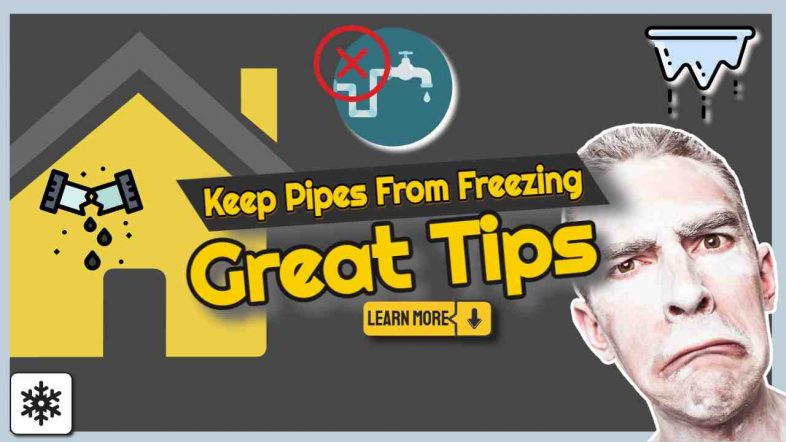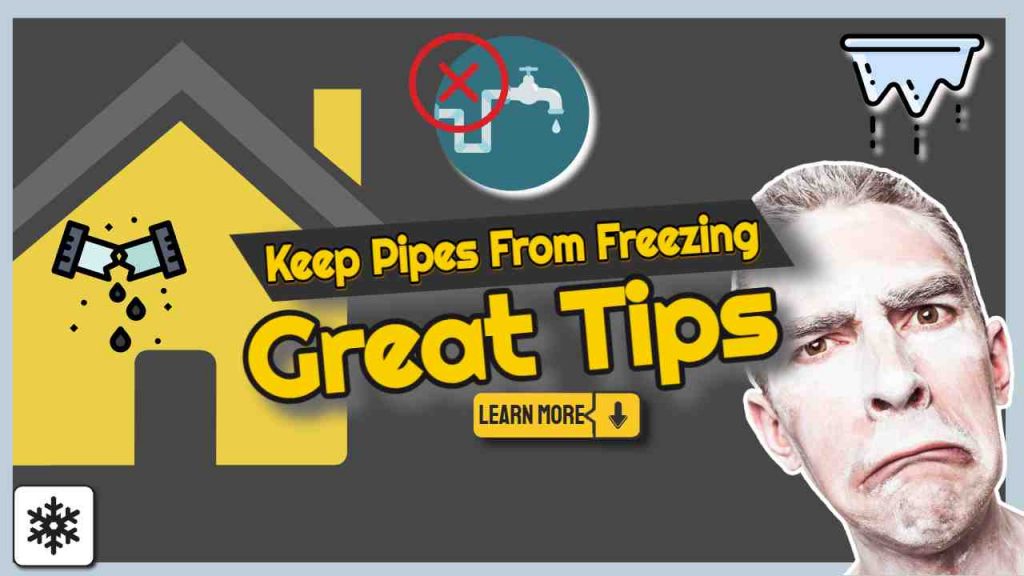
To keep pipes from freezing is really important. That way you can save a mint on repairing expensive water leak damage, let alone the disruption to your life.
Keep Pipes From Freezing – the Underlying Problem
Water may freeze in really cold conditions. Pipes will eventually freeze even when in a home if the temperature remains below freezing for a long period. Good insulation without any source of warmth can only prolong the period before a pipe freeze-up will occur.
Burst pipes are an issue because water expands as it freezes in a pipe and turns to ice. The strain on the pipes and couplings grows as the ice expands, forcing them to break or tear apart.
Turn off the water at the main cutoff if you're leaving town for a few days or longer. That way, if frozen pipes do break, the damage will be minimal. Turn off your automated icemaker so it doesn't try to manufacture ice all the time and burn out the engine. The ice will vanish even if the ice bin is full, and the icemaker will try to create more.
Pipes Which are More Susceptible to Freezing
Kitchen plumbing frozen pipes are particularly susceptible because they are often hidden behind closed doors (e.g. in cabinets), where the heat from the rest of the home cannot reach them. To enable warmth to travel into the cabinets, just open the cabinet doors before going away on a winter vacation.
Pipes on the inside of external walls tend to freeze before those on inner walls.
A fan or portable electric heater can be put on one of those frost-stat fitted thermostat plugs that are available for sale in most big DIY stores for homes/spaces without a heating system.
Take the time to locate your inlet water supply stopcock
Everyone should be aware of the location of their stopcock. You don't want to be frantically looking for it when your house is flooded and you have no idea how to stop it!
It's commonly found on the ground level, underneath a sink, near the stairs, or near the gas metre.
Here again, it's also a good idea to leave cabinet doors beneath the kitchen sink and bathroom cabinets open to allow warm air to circulate around pipes that are exposed to the cold or are fastened to the outer walls.
If you're not sure which pipes in your home carry water and which carry gas, try turning on the faucets. It's a water pipe if it vibrates or produces a sound while the water is running.
Leave Heating Systems on the Frost Protection Setting While Away
Make sure your pipes aren't exposed to temperatures below the warning level of 20 degrees to prevent them from freezing and bursting. It is feasible to arrange most heating systems such that they will fire up and maintain the rooms slightly above a pipe freezing hazard temperature without turning them off.
For most houses, this is a low-cost option that may save you a lot of pain by preventing your pipes from freezing while you're gone.
This is how to keep pipes from freezing in a vacant vacation home. When you return, be sure to adjust the thermostat to “auto” after utilising the frost-stat setting.
If your heating system is powered by oil or LPG gas
If your boiler uses oil or LPG gas, make sure you have enough fuel to keep your home warm over the winter and while you are away.
You don't want to run out of anything and then discover that your supplier is unable to supply because of the harsh winter weather. If you run out of oil, make sure to cut off the water at the mains stopcock and drain the water system. This should help keep pipes from freezing in the winter.
Pool Pipes: How to Keep Them From Freezing
Drain the water from the pool and sprinkler supply lines according to the manufacturer's or installer's instructions. Unless otherwise specified, do not use antifreeze in these lines. Antifreeze is hazardous to the environment and can affect humans, pets, animals, and landscaping.
What is the location of my internal stop tap?
What is the location of my internal stop tap so that I may shut off my water in an emergency?
The most frequent location for stop taps is beneath the kitchen sink. Another will be at the point where your house's water supply line connects to the main water supply pipe outside your home.
Your stop cock on the street or at the boundary of your property is almost always buried, homeowners and residents do not normally use this valve. Your water company is the only one who uses it.
If you can't find your stopcock under the sink, search around the outer walls of your house for additional water appliances, sinks, toilets, and other plumbing fixtures.
Pipe Rupture
In the case of a pipe rupture, getting to the main stopcock and closing the valve promptly can make all the difference. It's worth the effort to make sure you know where your internal stop tap is and that it's operational, as you could need it in an emergency, such as a broken pipe.
Additional Pipe Burst Prevention Advice
In the winter, flush the toilets and pour one or more spoonfuls of salt down the toilet or sink to keep the water from freezing.
We recommend using a foam tube called “lagging” to cover all of your water pipes, even those outside your home. An inexpensive, simple to install, and can be found for under £3 at most DIY stores. Remember to use waterproof lagging for any pipes that will be exposed to the elements.
Keep Pipes From Freezing in Your Garage
If you have water pipes in your garage you should insulate them.
You just need to be concerned about the water supply pipes, not the drain pipes, regardless of where you reside. But how do you know which is which?
Water pipes are tiny, with a diameter of around 1 inch or less. Drain pipes are generally constructed of plastic and are 1.5 inches in diameter or bigger. Drain pipes transport wastewater but do not store water and are not pressured like water pipes, thus freezing is not an issue.
Every Autumn, make sure you're ready for the winter weather!
Ensure that taps, cold water tanks, piping, and appliances are inspected on a regular basis. Do not overlook symptoms of water leaks; if left unattended, they can cause significant damage to a home. Repair leaks as soon as possible.
Air Quality in the Home
Wind cold also contributes to the freezing of pipes. The cooling effect typically increases ice formation in unheated areas with holes, fractures, or openings that enable cold, outside air to blow in. Even minor gaps, such as the little holes that allow telephone, cable, internet, or television lines to enter a room, can let a hazardous quantity of cold air into a structure.





